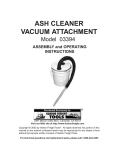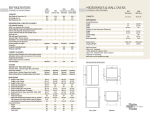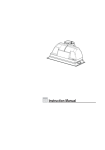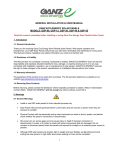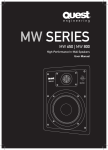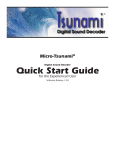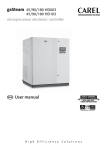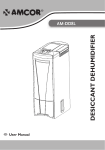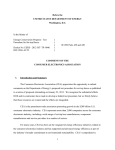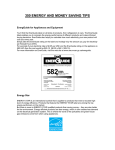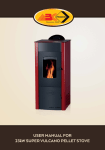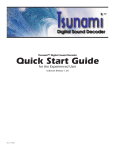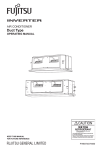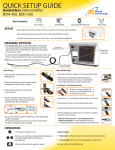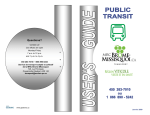Download How_do_you_rate 489KB May 07 2010 08:48:04 AM
Transcript
How do you rate? Interested in learning how your habits at home are linked with the environment? Take the ecoENERGY Retrofit – Homes Questionnaire and discover how your energy choices can make a difference. T he ecoENERGY Retrofit – Homes Questionnaire is a tool designed to help you become more aware of how your home uses energy and how your energy choices affect the environment. This approach There are many small, difficultto-measure actions that you, the homeowner, can take to reduce your impact on the environment. Even small steps, when taken together with those of other homeowners, can help to protect our environment. The first of the three parts of this questionnaire focuses on the type of appliances and equipment that you use in your home. The second part addresses conservation and environmental measures that you take as a homeowner. The third part considers the energy efficiency rating of your home that was presented by your energy advisor following your ecoENERGY pre-retrofit evaluation. When you complete the questionnaire, check all the boxes that apply to you. Refer to the “Information and Tips” section (references 1 to 16 ) to help you complete the questions and to find tips on how to save energy in the home. takes into account not Part 1 – Appliances and Equipment only your home’s energy (A) Heating, Ventilation and Air-Conditioning (HVAC) Equipment consumption, but also, its Place a check mark in the box if impact on the surrounding infrastructures on which it relies (e.g. sewage treatment, provincial/territorial electricity capacity). 1.. your home does not have air conditioning 2. your home has an ENERGY STAR® qualified 1 air conditioner 2 or heat pump 3.. your home does not have a solid-fuel-burning appliance (such as a fireplace or a woodstove) 4.. your home has a solid-fuel burning appliance 3 that has an advanced combustion system Subtotal for HVAC Equipment: the points.) (See 4 to calculate (B) Household Appliances Part 2 – Other Options Place a check mark in the box if your home has (D) Conservation and Environmental Measures 5.. an ENERGY STAR qualified refrigerator or refrigerator-freezer 6.. an ENERGY STAR qualified freezer, clothes washer or dishwasher 7. no second refrigerator/refrigerator-freezer or additional freezer 5 8. no dehumidifier or ceiling fan, or if you have one or more, they are ENERGY STAR qualified 9. at least three ENERGY STAR qualified consumer electronics or home office equipment (e.g. DVD player, television, computer and peripherals, such as printers and scanners) Subtotal for Household Appliances: (See 6 to calculate the points.) (C) Energy-Efficient Lighting Place a check mark in the box if 10.. you have at least eight compact fluorescent light bulbs/lamps (CFLs) used in at least five different fixtures for general lighting (indoor and outdoor) Note: Light-emitting diode (LED) lights can replace CFLs, but night lights and seasonal string lights are ineligible 11. you use at least two lighting controls, such as motion sensors, dimmers and timers Subtotal for Energy-Efficient Lighting: (See 7 to calculate the points.) Place a check mark in the box if (Check 12 or 13, but not both) 12.. you have central heating that uses electronic or electronic programmable thermostats to control the heating temperature 13. you heat your house predominately with electric baseboard heaters controlled by a minimum of five electronic thermostats or electronic programmable thermostats that are wall-mounted 14. you lower the heating temperature at least 3°C (5°F) overnight and when you are not at home 15. you set your thermostats no higher than 21°C (70°F) during the heating season 16. you routinely close curtains or blinds on sun-exposed windows during the day in summer to help keep the house cool, and close most curtains and blinds at night in winter to help keep the house warm 17. you do not have an air conditioner or you set your thermostat to turn your air conditioner on at 26°C (79°F) or higher 18. you routinely use cold water to wash and rinse your clothes 19. you use an outdoor clothesline when the weather permits 20. you use timers to delay the use of appliances until electrical off-peak periods 8 21. you turn on your dishwasher only when it’s fully loaded and you use the air-dry feature 9 22. you turn off lights when you leave a room or when they are not needed 23. you use at least one power bar with an on/off switch that you turn off when you are not using the connected appliances, entertainment and office devices to reduce standby losses 10 24. you do not use an engine block heater or you use a timer for the heater that is set for two hours or less 25. you use low-flow shower heads, low-flow/ dual flush toilets 11 and low-flow aerators on faucets, and have repaired all water leaks 26. you have insulated at least the first two metres of the metal hot- and cold-water pipes connected to your water heater 12 27. you do not have a swimming pool, or, if you do, you use a pump timer to regulate the length of time your pool pump operates; or you use solar heating and a thermal pool blanket; or you do not heat your swimming pool 28. you do not heat your home or domestic hot water with oil, or, if you do, you have an oil-leak detection system 13 29. you and others in your household use mostly alternate transportation, such as public transport, carpooling, bicycling and walking 30. you recycle all recyclable materials, compost your organic kitchen waste 14 and send toxic waste to a toxic waste depot (e.g. batteries, paints, pesticides) Subtotal for Conservation and Environmental Measures: (See 15 to calculate the points.) Part 3 – Energy Efficiency Rating (E) Energy Efficiency Rating on the EnerGuide label: Subtotal for the Energy Efficiency Rating: (See 16 to calculate the points.) Total Score (Addition of subtotals A, B, C, D and E): Check Your Environmental Rating Although many Canadians are already taking steps to conserve resources and protect the environment, most of us can do better. Find your total score in the left column of the chart below and check how you rate. Environmental Score Range 0–10 Rating Low Comments Time to roll up your sleeves 11–40 Marginal 41–65 Good 66–79 Very good 80–100 Excellent! Ahead of the pack! Lots of opportunities Still room to make a difference Efforts realized. Keep up the good work! Congratulations! Information and Tips This section will help you to complete the questionnaire as well as provide you with tips on saving energy and resources in the home. 1 ENERGY STAR qualified appliances and products are among the most energy efficient in the marketplace and are considered best in their class. If the ENERGY STAR sticker is not visible, check the owner’s manual or the back of the equipment. If you cannot find an ENERGY STAR logo or sticker, you can compare the annual energy consumption listed on the black-and-white EnerGuide label (or on the yellow-and-black United States EnergyGuide label) against the values of ENERGY STAR appliances in the EnerGuide Appliance Directory. Typically, ENERGY STAR appliances are in the top 25 percent of energy efficiency performance. For more information, visit the ENERGY STAR Web site at www.energystar.gc.ca. To obtain a copy of the EnerGuide Appliance Directory, call 1-800-O-Canada (1-800-622-6232). 2 ENERGY STAR qualified air conditioners include conventional central-air systems and all window, wall or multi/mini split air conditioners. Heat pumps include air-source, water-source and ground-source heat pump systems. 3 Solid-fuel-burning appliances are fireplaces and stoves that burn wood, pellets, corn and other grains and seeds. Those with advanced combustion technology have highly efficient combustion systems that re-burn combustion gases before they leave the appliance. Highly efficient combustion systems are certified as CSA-B415.1 or EPA, 40 CFR Part 60, and they include firebox insulation to keep temperatures high; preheated primary combustion and secondary air that is fed to the fire through sets of small holes above and behind the fuel bed; and internal baffles that give the fuel gases a long and hot enough route so that the gases can burn completely. 4 Based on statements 1 to 4, tabulate your sub-score. Number of Boxes Checked Points Two 10 One 5 5 Extra refrigerators and freezers can cost more than $10 a month in electricity. If you need a second refrigerator or freezer, keep its coils and air inlets clean; ensure the door seals are tight; keep it defrosted; and keep it full but not overloaded. Better still, buy the correct size ENERGY STAR qualified refrigerator or freezer for your needs: they are 40 percent less energy when compared with one built in the 1970s.) Unplug these extra appliances when not in use. 6 Based on statements 5 to 9, tabulate your sub-score. Number of Boxes Checked Points Four to five 20 Three 15 Two 10 One 5 7 Based on statements 10 and 11, tabulate your sub-score. Number of Boxes Checked Points Two 10 One 5 8 Electrical peak-load reduction can be good for homeowners and the environment. Reducing electrical power consumption during peak hours can lower energy bills where “time of use” metering is available. It restores grid operating margins that prevent brownouts and blackouts, reduces demand on non-renewable and dirty fuel sources, delays or avoids construction of new electrical generating plants and reduces greenhouse gas and pollution emissions. Simple actions that homeowners can take include using timers to delay use of heating/cooling equipment and appliances, such as clothes washers and dishwashers, to times outside electrical peak periods. (Typically, peak periods are weekdays from 7 to 11 a.m. and 5 to 10 p.m.) 9 A relatively common assumption is that washing dishes by hand saves hot water. However, washing dishes by hand several times a day could be more expensive than operating a fully-loaded automatic dishwasher. An ENERGY STAR qualified dishwasher may consume less energy due to “smart sensors” that adjust the wash cycle, rinse volume and the amount of water to match the load. ENERGY STAR qualified dishwashers also typically use only 13 to 27 litres of hot water compared to older appliances that use from 30 to 53 litres. A built-in booster water heater with a manual selector switch can raise the water temperature at least 20 degrees for less than it costs to keep the water heater temperature that high. Many electric and electronic devices consume 10 electricity even when switched off. Typically, these units include remote or soft-touch controls, monitors, clocks, electronic timers and LED lights. When power bars are switched off, electronic devices are still protected from power surges. However, keep in mind that some recording devices, such as video and DVD players, may lose their programming set-up if switched off by a power bar. Remember to switch off power bars during extended periods of non-use, such as during vacations. Over 30 percent of indoor residential water 11 consumption is a result of toilet use. In a recent study, dual-flush toilets saved approximately 26 percent more water than conventional 6-litre toilets when used to replace existing non-efficient toilets that averaged 14 litres. Consideration of other toilet water conserving methods such as water displacement devices can help conserve water while reducing waste treatment costs. To reduce heat loss, insulate at least the first 12 2 metres of the metal hot- and cold-water lines from the hot-water heater, especially if they run through unheated areas, such as basements and crawl spaces. Insulation can save about 2 percent on heating bills and can reduce pipe-sweating problems in the summer. Do not place pipe-wrap insulation within 15 centimetres of exhaust vents at the top of gas- or oil-fired water heaters. Insulate plastic pipes only with an approved type of insulation, to avoid damaging plastic pipes and fittings. If you will be away from your home for 3 days or more, remember to switch off or turn down your water heater thermostat to a minimum setting (e.g. vacation setting). For more energy-saving tips, read the user’s manual for your home’s water heater. You can protect your home and property from 13 oil leaks by using double-wall or plastic-lined oil tanks, non-metallic oil tanks, and tank and burner drip trays that have leak detection alarms. If you cannot compost your kitchen waste 14 because you do not have enough yard space or access to a communal composter, score this question just based on recycling. Use of curb-side recycling programs (e.g. paper, glass, metals and organics) or use of recycling centres helps to reduce landfill loads while allowing the re-use of these materials for other purposes. Never dispose of toxic waste (e.g. batteries, paints, solvents, unused medication, CFLs, pesticides and herbicides) in regular garbage, a composter or down a drain. Instead, send them to your local recycling centre or toxic waste depot. Send unused medications to a pharmacist. Based on statements 12 to 30, tabulate your 15 sub-score. Number of Boxes Checked Points Fifteen to eighteen 40 Eleven to fourteen 30 Seven to ten 20 Four to six 10 One to three 5 The energy efficiency rating considers the 16 existing insulation levels of all building components, type and efficiency of mechanical systems (space heating, water heating and ventilation equipment), and air-tightness levels. Based on the energy efficiency rating on your EnerGuide label, the following points are assigned. Energy Efficiency Rating Points 0 to 40 0 41 to 60 5 61 to 70 8 71 to 75 14 76 to 79 17 80 or higher 20








